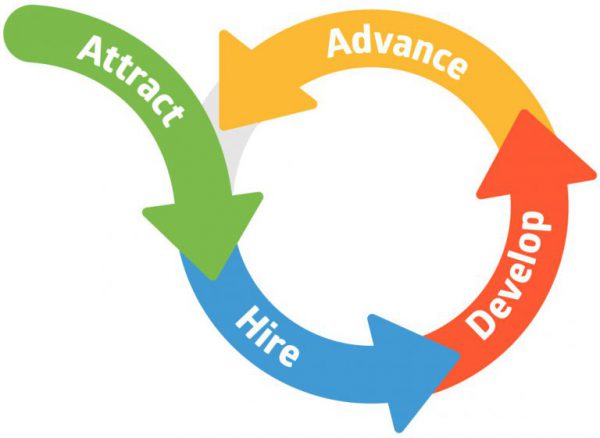Human resource (HR) processes are crucial for a business. It’s essential for all businesses, large, small, and medium-sized, to acknowledge the importance of HR processes and consistently work towards ways to improve them, whether through improving payroll processing or employee onboarding.
HR processes play a vital role in enabling and empowering people and developing a strong company culture. However, when it comes to profitability and cost-cutting, HR is often overlooked. Businesses that struggle with HR processes often face issues with high turnover, low productivity, and legal liabilities.
Well, there are various ways to improve HR processes to save yourself time and money in the long run. But if you’re wondering where you should focus your attention, here are seven ways to start.
7 Ways to Improve HR at Your Organization
Improving HR processes is not only a way to increase productivity in the workplace, but it also saves you time and money in solving compliance issues. Below are 7 proven ways you can improve your business’s HR processes and become more efficient.
Conduct HR Assessments
You cannot improve if you are not aware of the current situation. This is called HR assessment. It’s a comprehensive evaluation of your existing HR processes. An HR assessment gives you an overview of the HR practices in your organization, such as payroll, recruitment, performance management, and so on. The purpose of an HR assessment is to identify:
●
gaps and areas of improvement in HR processes
●
whether or not the current HR process is meeting the needs of the business
●
whether HR practices are aligned with your business goals
The HR assessment report will clearly identify any issues and help you make improvements.
Use Data Analytics to Make Informed Decisions
Data can provide valuable insights into core HR processes without requiring manual time and effort. More and more small and medium businesses (SMBs) are using dashboards and reporting software to make decisions and identify opportunities for improvement.
Data-driven reports can help you identify trends in employee turnover, quantify employee performance, and measure the impact of training and development programs. In fact, data can also suggest the right recruitment strategies.
However, to get that data and to analyze it without going insane, automation is the key!
Adapt to a Cloud-Based System
Gone are the days when HR systems required manual updates and physical servers. Most companies are adopting cloud-based HR systems, which means your software is hosted on the internet.
Cloud-based HR systems come with many benefits:
●
Improved security
●
Easier access to information
●
Real-time updates
●
Improved compliance
●
Increased productivity
A large portion of SMBs are still using paper-based HR processes, which take extra time and money. If you are one of them, consider adopting a cloud-based system.
Automate Routine Tasks
Routine tasks are repetitive, and most organizations don’t give it a second thought. However, routine HR tasks make a tremendous yearly impact on your productivity and efficiency. A report shows that HR staff spends 57% of their time on administrative tasks, leaving little to no time for strategic tasks.
Automating repetitive and tedious HR tasks can free up time for HR managers to focus on more initiatives. Most HR professionals would rather take part in more impactful projects instead of spending time on spreadsheets.
Some tasks you can easily automate are data entry, leave management, employee status changes, report generation, and benefits functions. With the right tools and software, you can even develop and check metrics for ROI.
Automate Payroll Processes
Organizations that automate payroll processes observe huge time savings. However, the most important benefits of automating payroll processes are from a compliance perspective. The right payroll software can reduce errors and mitigate risks, ensuring regulatory compliance and helping companies avoid penalties.
Using payroll software, a company can track:
●
Employee hours
●
Tax withholding
●
Benefits contribution
●
Performance
●
Time-off updates
An automated payroll system makes it less burdensome for organizations to manage data and keeps the entire process standardized.
Automate Talent Management
Hiring, onboarding, and managing employees takes much more time and resources than most organizations realize.
A study showed that automation can reduce onboarding time by up to 80%.
Employee onboarding, time-off and attendance tracking, training and development, and employee data management are just a few examples of talent management tasks that can be automated to enhance security and increase productivity at your organization.
Using automated and AI-augmented hiring tools can also reduce your cost-to-hire by 78%.
Introduce Employee Self-Service
Employee self-service refers to empowering employees to do certain HR tasks and operations themselves without relying on HR personnel. Organizations can provide employees with a single, centralized platform to manage their HR-related activities, such as submitting time-off requests, viewing paychecks, and checking benefits information.
When employees perform these tasks independently, it leaves time for HR heads to focus on strategic policies and improvement plans. It also lightens the burden on your administration and allows easy accessibility for everyone. When employees gain more control over such operations, they also feel empowered, which impacts productivity.
So, Where to Begin?
HR departments can contribute to an organization’s profitability by improving their processes and saving time and costs. However, around 57% of HR professionals report being understaffed and working beyond capacity on routine, repetitive tasks.
Improving HR processes through annual HR assessments, data-driven decision-making, cloud-based system management, and employee self-service can enhance productivity. Standardized automation of processes like talent management, payroll, and day-to-day activities can also have a huge impact on organizational efficiency. Start improving your HR processes today with these simple but effective tips.




